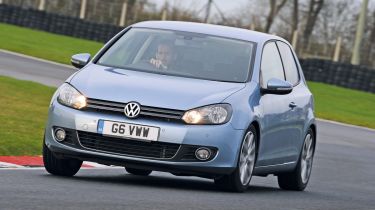Volkswagen Golf GT
Twin-charged petrol engine is designed to liven up this sensible family car choice
If any car should be able to give the Ford Focus Zetec S a run for its money, it’s the Volkswagen Golf. It has set the benchmark in the compact family car sector for years and the GTI version is our favourite hot hatch. So does the 1.4 TSI GT fit the brief here as a halfway house between the ordinary models and the performance flagship?
On the outside, GT trim gives the Golf’s conservative looks a subtle boost: there are chrome accents for the grille and foglights, a lower ride height and 17-inch alloys. But it’s still very sober overall. Our pictures show a three-door model, but the five-door tested shares its upright profile and the VW is the least likely of our trio to turn heads.
You probably won’t care about that from the driving seat, as the Golf provides the most luxurious cabin. Judged purely on the quality of its design, layout of its controls and standard of its materials, the VW is in a different league to its rivals.
Its smart instruments, classy switchgear and comfortable driving position are Golf trademarks, but GT trim adds leather upholstery, heated front seats and a multifunction leather steering wheel, plus Bluetooth and iPod connectivity.
Used - available now

2023 Ford
Focus
13,377 milesManualPetrol1.0L
Cash £17,989
2022 Ford
Focus
8,380 milesManualPetrol1.0L
Cash £19,236
2021 Ford
Focus
21,356 milesManualPetrol1.0L
Cash £16,555
2023 Ford
Kuga
25,148 milesManualPetrol1.5L
Cash £19,440The hide upholstery and heated seats help justify the £21,895 Golf’s £1,400 premium over the Ford, but the VW is the only car here not to feature a DAB radio (it’s a £185 extra). And it’s not possible to match the Leon’s spec, as xenon lights aren’t even available as an option.
Rear space is par for the course in the family car sector, and the car’s 350-litre boot is the largest here. This all suggests the Golf is the sensible option, but that alone isn’t enough. To succeed in this test, it needs to deliver driving thrills, too.
The engine has an important role to play here, and the 1.4-litre TSI is a technological tour de force. As with its rivals, the four-cylinder uses a turbo to boost power at high revs, but unusually, it’s also fitted with a supercharger to improve its responses low down in the rev range. Together they help make 158bhp and 240Nm of torque.
The latter figure matches the Ford, although the VW trails the Zetec S on power. Both cars lagged behind the faster SEAT against the clock on the track, but there’s little between them. To gauge the difference, you really need to drive them on the road, as this is where the Golf’s weaknesses become more apparent.
Unfortunately, the GT’s 15mm drop in ride height over standard models really hampers comfort. The stiff set-up struggles to cope with poor surfaces. It transmits vibrations into the cabin that are filtered out by the more forgiving Focus. This compromise would be fine if it transformed the way the Golf handles, but it doesn’t.
Quite simply, the GT doesn’t attack corners with the same enthusiasm as the Ford or SEAT, and suffers from more body roll. There’s still plenty of grip on offer, and the weighty steering is precise and confidence-inspiring, but it doesn’t provide the same fluid responses you get behind the wheel of the Zetec S.
And the engine isn’t flawless, either. Although the 1.4-litre turbocharged petrol is smooth and willing as you power through the rev range, there’s a slight flat spot at 3,500rpm under moderate acceleration. This version of the Golf is still highly talented, though.
Its tidy handling, positive gearshift and high-speed refinement all count in its favour, and the GT’s brakes are more progressive than the grabby ones fitted to the SEAT.
The problem is that buyers looking for a sporty family hatch will be disappointed.The more extrovert Leon FR+ is faster and more stylish, while the Focus Zetec S is more engaging and enjoyable to drive. Faced with that combination, the Golf GT could struggle here.
Details
Chart position: 3
WHY: The Golf is the consummate family car. Yet while the regular models and the top-of-the-range GTI are acknowledged class leaders, how does the halfway-house GT version fare?







